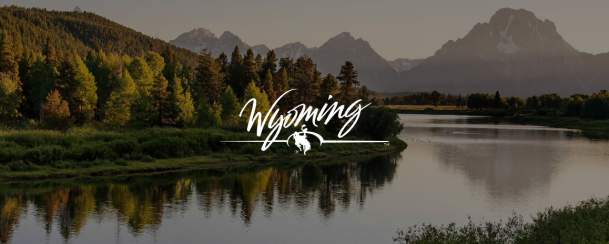From Yellowstone’s famed geysers to the towering Tetons, Wyoming is home to some spectacular natural and manufactured wonders, many of which have left tourists — and even some scientists — scratching their heads in disbelief.
While some curious sights are gifted to us by the natural world, some are designed by humans, and all can be a unique part of your next getaway. Check out 17 of the most wonderfully bizarre Wyoming landmarks.
1. Heart Mountain
Where to Find It: Lane 13H, between Cody and Powell, Wyoming
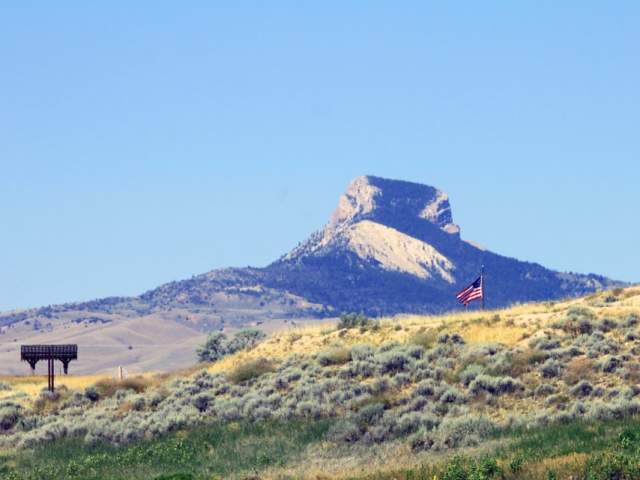
Located just outside Cody, Heart Mountain was once part of the Absaroka Mountain Range and later became a famous Wyoming rock formation for a different reason. Whether the 8,123-foot peak had a tiff with its rocky neighbors or just wanted a change of scenery, the mountain moved about 25 miles away — all on its own. While some insist it’s the work of aliens and giants, scientists offer a different, but hardly less stunning, explanation:
Fifty million years ago, volcanic eruptions in the Absaroka Range rocked the area. Water-filled ditches within Heart Mountain became packed with lava, which heated the water and surrounding rock. With nowhere for the lava and hot water to escape, the mountain became a giant pressure cooker, eventually lifting the stone and causing the mountain to slide. While some scientists predict that the slide took place over thousands of years, others suggest that the journey lasted fewer than 30 minutes, meaning the vast mass of rock traveled at an average speed of more than 100 miles per hour.
2. Killpecker Sand Dunes
Where to Find It: North of Rock Springs in Sweetwater County, Wyoming
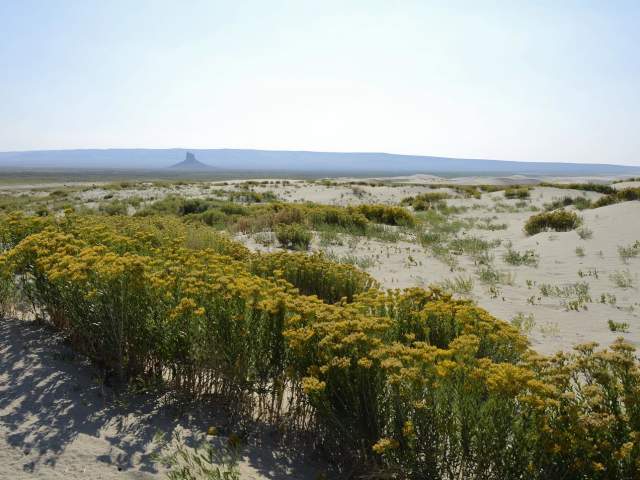 Photo Credit: @jordanphotousa
Photo Credit: @jordanphotousa
Positioned just a few miles north of Rock Springs in the Red Desert, Killpecker Sand Dunes are one of only seven “booming” or singing dunes worldwide, so visitors can expect to hear distinctive roaring or whistling sounds at the landmark.
How do singing dunes work? Killpecker’s sand grains are rounder and more polished than those of non-booming dunes. Subsequently, as the wind passes over the dunes or visitors walk on the grains, the smooth sand slips and slides down the sides of the hills, producing the inimitable sounds that make it one of many must-see Wyoming natural attractions.
3. Boar’s Tusk
Where to Find It: Off of Chilton Road, north of Rock Springs, Wyoming
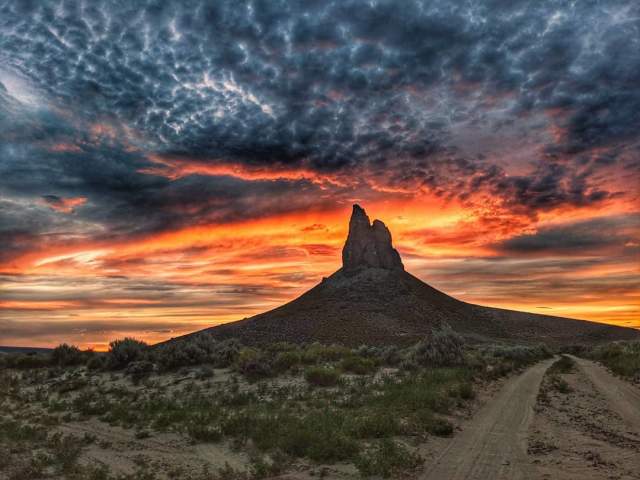 Photo Credit: @krszjz
Photo Credit: @krszjz
Boar’s Tusk, the core of an extinct and eroded volcano, protrudes out of Killpecker Sand Dunes’ otherwise flat landscape. The volcanic plug is one of two geologically formed Wyoming landmarks; the other is Devils Tower in the state’s northeastern corner (see #4 on our list for more information.)
The spire that makes up Boar’s Tusk’s summit is also known as the Sentinel or Rock Point. Four-wheel-drive vehicles are recommended for exploring Boar’s Tusk and the surrounding Red Desert outside Rock Springs.
4. Devils Tower National Monument
Where to Find It: WY-110, Devils Tower, WY 82714
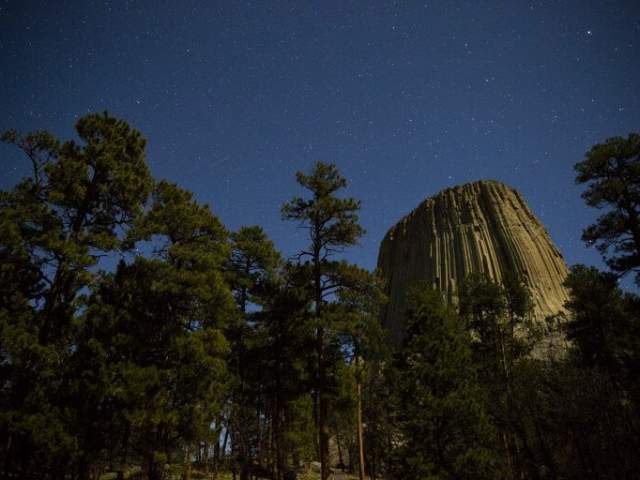
Erosion is credited for revealing Devils Tower, a massive, once-hidden monolith that towers 1,267 feet above the Belle Fourche River near Sundance. The park surrounding this classic Wyoming rock formation, home to deer, prairie dogs and other wildlife, is blanketed with pine forests, woodlands and grasslands.
Also known as Bear Lodge, the monolith is a sacred place for many local Native American tribes, including the Arapaho, Crow, Cheyenne, Kiowa, Lakota and Shoshone. According to tribal legends, the stone was uncovered with help from the Great Spirit to save playing children from an enormous bear. President Theodore Roosevelt designated Devils Tower as the nation’s first national monument in 1906.
5. Sinks Canyon
Where to Find It: 3079 Sinks Canyon Rd, Lander, WY 82520
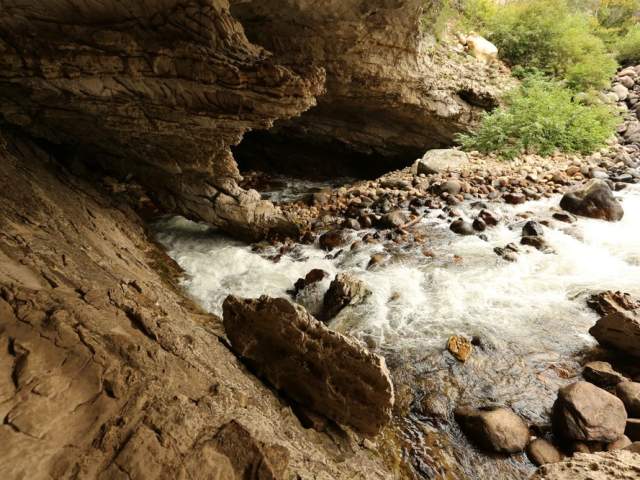
Sinks Canyon State Park, located just outside of Lander, is home to a disappearing river that tops the list of famous Wyoming natural attractions. The middle fork of the Popo Agie River (pronounced po-po-zsha) rushes out of the Wind River Mountains and flows until it suddenly curves into a large cave and descends underground, an area aptly dubbed “the Sinks.” Then, the river wondrously re-emerges about a quarter mile away in a large, calm pool called “the Rise.”
Until scientific tests using colored dye confirmed that the two are connected, no one knew that the water at the Rise was the same water that disappeared into the Sinks. Tests also revealed that more water emerges at the Rise than is initially found at the Sinks, which remains an unexplained phenomenon.
6. Jackalope Square
Where to Find It: 100 S 3rd St, Douglas, WY 82633
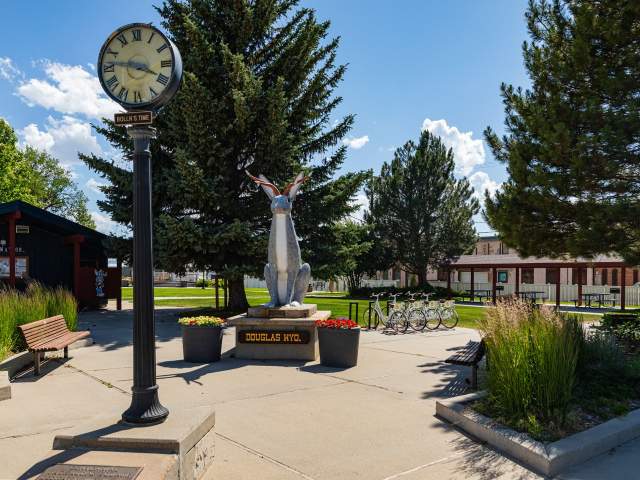
While it may be a man-made Wyoming landmark, the star of Douglas, a city in the east-central part of the state, is an ode to a mysterious and infamous critter. The center of downtown was christened Jackalope Square in honor of the half-hare, half-antelope that is said to be born of two taxidermists’ imaginations and is home to a larger-than-life statue of the creature. The jackalope lore, however, is deeper and more far-reaching than you might think: some locals claim the animal is real and shyly inhabits the wilds of Wyoming but are notoriously hard to spot or catch.
Stop by the jackalope’s stomping grounds, and you will find a lovely park with plenty of green space, ample seating and the perfect spot to barbecue or have a picnic. There is more to explore in the city of Douglas, but if the hope of hunting down your own jackalope brings you by, make sure you pop into the Douglas Railroad Museum & Visitor Center first to get your hunting license.
7. Castle Gardens Petroglyph Site
Where to Find It: In Central Wyoming on Wyoming Route 136, east of Riverton
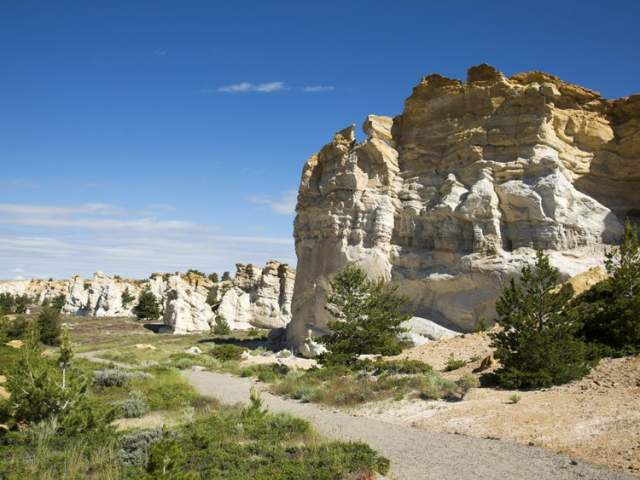
Suppose you travel about 45 miles east of the town of Riverton. If you do, you’ll find that the wind has eroded sandstone outcroppings into turrets and towers, forming a stone fortress that is an incredible Wyoming natural attraction. In addition to being structurally stunning, Castle Gardens is the canvas for hundreds of examples of Native American rock art known as petroglyphs, making it even more fascinating the closer you get to it.
Plan a day to hike around the site, and pack a camera and a notebook to document any exciting or inspirational sights you stumble upon. Visitors can admire the power of nature creating its own stone palace and identify turtles, warriors, shields and other designs carved and painted into the rock.
8. Hole-in-the-Wall Outlaw Hideout
Where to Find It: Route 25 S from Kaycee, Wyoming, to TTT road, 82639 at Willow Creek Ranch
If the call of saddles and spurs beckons to you on your next getaway, few famous Wyoming landmarks are better for an authentic cowboy experience than the Hole-in-the-Wall Outlaw Hideout. At the base of the Bighorn Mountains and tucked into a rock wall weathered by time and cold temperatures, this desolate space housed some of the most infamous bandits in the West, from Jesse James to Butch Cassidy and more. Remote enough to graze cattle and build cabins while remaining hidden from public view, Hole-in-the-Wall served as a home-away-from-home for many renegades.
These days, the property is still great for grazing but less for harboring outlaws. Hole-in-the-Wall belongs to Willow Creek Ranch, a working dude ranch founded on a much smaller scale when the outlaws ran the West. You may book a visit to the ranch and see the space for yourself, and take advantage of their many other amenities, such as fishing, hunting and moving cattle.
9. Hell’s Half Acre
Where to Find It: State Hwy 20/26, Powder River, WY
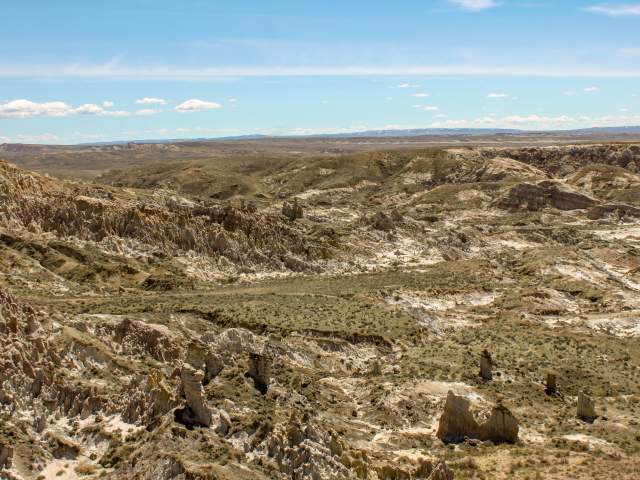
Nearly 300 acres in size, Hell’s Half Acre is a group of jagged ravines and rock formations 40 miles west of Casper. Spiny, spindly, and spiky, the optics of this canyon-like area seem otherworldly, with striped rocks stained in shades of red. Other names for the site have included The Devil’s Kitchen and The Pits of Hades.
While Native Americans local to Hell’s Half Acre used it to drive buffalo off the high cliffs during their hunts, visitors from around the country come to marvel at its strangeness today. They’re not the only ones captivated by it — filmmakers used the geologic anomaly as a backdrop for a distant planet infested with alien bugs in the movie “Starship Troopers.”
10. Vedauwoo
Where to Find It: Buford, WY 82052
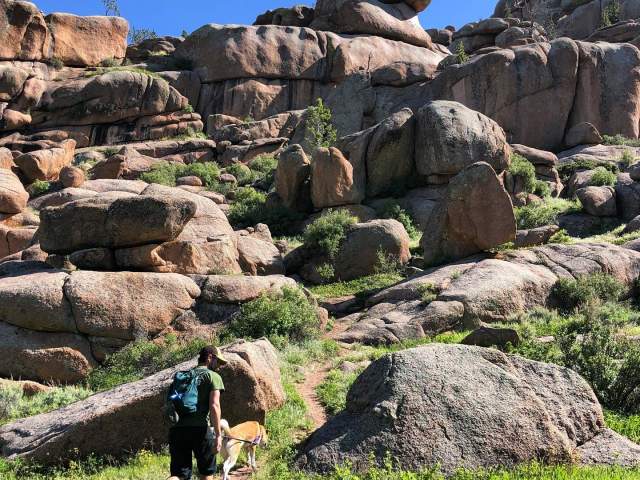 Photo Credit: @mharahush
Photo Credit: @mharahush
Vedauwoo, also known as the “Land of the Earthborn Spirit” by the Arapaho Indians, is a unique and popular Wyoming rock formation that attracts adventurers from all over the globe. Located just 15 miles east of Laramie, the pillar-like pattern of the stones is a real eye-catcher, but it’s more than just lovely to look at.
If you’re into rock climbing, Vedauwoo is the spot for you, offering visitors some of the best traditional climbing in the West. Also known for camping and hiking, this recreation area is a great place to spot some ancient rocks — it’s home to the Sherman Granite formations, some of the oldest in the entire state, dating back about 1.4 billion years.
11. Parting of the Waters National Landmark
Where to Find It: Two Ocean Pass on the Great Divide, Bridger-Teton National Forest, Moran, WY

In the Teton Wilderness area of the Bridger-Teton National Forest, visitors can stand in the waters of the Pacific and Atlantic oceans at the same time at Parting of the Waters Natural Landmark. Two Ocean Creeks on the Continental Divide split into two adjacent bodies of water called the Atlantic and Pacific Creeks. After the separation, the creeks continue to flow, join more significant streams and eventually make their way to the oceans. Put one of your feet in Pacific Creek and the other in the Atlantic Creek at Parting of the Waters to feel the rush of two ocean waters at once.
Of course, there is plenty more to explore while hanging out in the forest; depending on the time of year you visit, you can embark on a horseback ride, do some skiing or spend a day floating on the Snake River. There is also an array of wildlife to observe, including bison, wolves, elk and more.
12. Ames Monument
Where to Find It: 210 Monument Rd. Buford, WY 82052
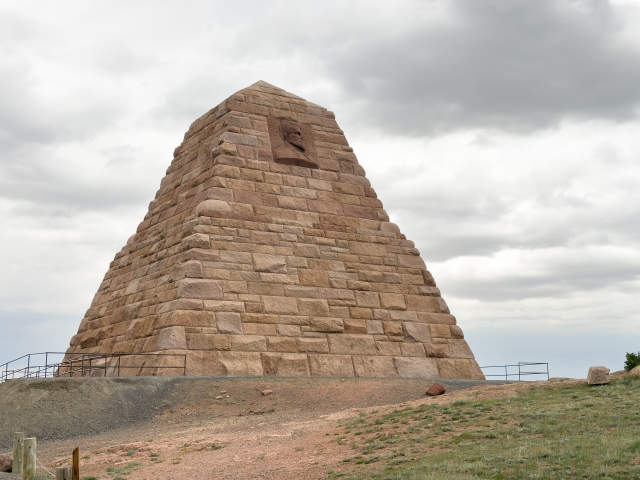
Wyoming’s famous landmarks have a lot to offer, but one thing you may not expect to see is a pyramid as you cruise through the state. That’s part of what makes the Ames Monument such a striking sight. Built to honor the men who saw the Transcontinental Railroad through to completion, the 60 x 60 granite pyramid is one of very few in the U.S., making it an obvious choice for fantastic sightseeing.
Despite the railroad no longer running through that spot in Buford, the pyramid is a testament to its importance in Western development. And, in case you were wondering, it is hollow with pathways to walk on the interior. However, after an expedition to confirm that fact in 2010, the building was restored, and there is no public entry point.
13. Medicine Wheel
Where to Find It: near Lovell, in north-central Wyoming, in the Bighorn National Forest
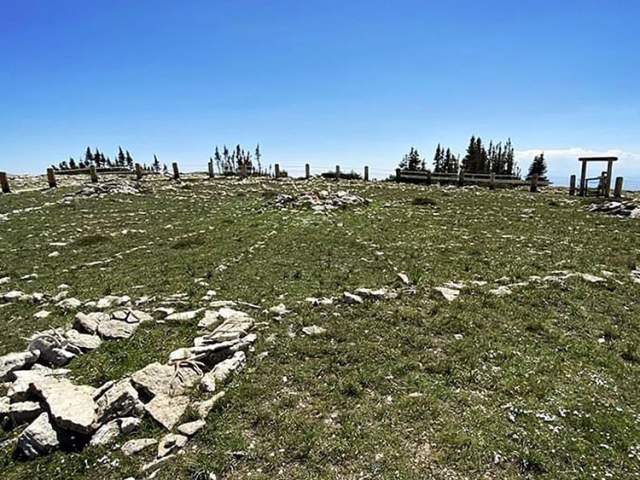
Legend meets history meets astronomy at the Medicine Wheel, a revered cultural landmark in the Bighorn National Forest. At 82 feet in diameter and nearly 10,000 feet in elevation, this sandstone circle is divided into spokes like a wheel. Used to represent time-keeping by Indigenous tribes throughout generations, each of these spokes points to a celestial event on the horizon line, including sunrise and sunset from that spot.
The Medicine Wheel is considered a sacred site, and while visiting it is possible, it’s important to keep respect for Native traditions at the forefront when you do. Observe any closures they may have to the public when a ceremony occurs there, do not disturb any bundles or prayer cloths you find at the site and leave the stones as you found them when you go.
14. Smith Mansion
Where to Find It: 2902 North Fork Highway, Cody, Wyoming, 82414
When you think of a log cabin, you likely think of something small, demure and rustic. The Smith Mansion, a local-favorite landmark in Cody, makes you rethink those preconceived notions. This home was built by an engineer named Lee Smith, who, after creating a baseline home for himself and his family, continued using found wood to add to the structure long after most people would have stopped. However, the local lore about the house ranges from presuming that he built it as a joke to wondering if it was built over a mine shaft.
After suffering a terrible accident, ownership of the home changed hands a couple of times, and it is not presently open to the public to tour. Still, you can spot the house from the road, particularly if you’re on your way to visit Yellowstone. Take a peek, and take in the incredible backdrop that frames this one-of-a-kind home.
15. Wyoming Frontier Prison Museum
Where to Find It: 500 W Walnut St, Rawlins, WY 82301
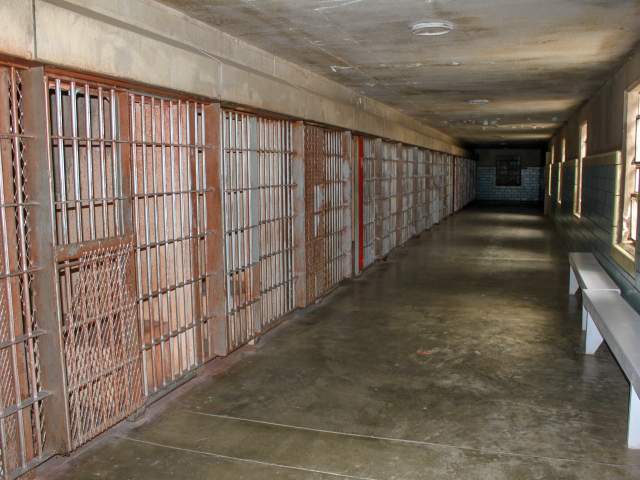
Western history is nothing without its outlaw stories, and the truth is that many of them wound up spending some time at what was the Wyoming State Penitentiary in Rawlins. When Wyoming became a state, the West was being settled, and there was a push to crack down on some of the illegal activity it was so well known for. Then, for the 80 years that followed, it carried out that very vision, housing some of Wyoming’s most notorious criminals.
These days, the historic landmark is now known as the Wyoming Frontier Prison Museum, a popular destination for visitors to get up close and personal with where history’s most infamous served their time. You can tour the grounds, the cafeteria and cell blocks to see where both male and female inmates slept and broke bread. There are also many exhibits providing detailed information on the life and times of the prison’s best-known residents.
16. Chugwater Soda Fountain
Where to Find It: 114 Main St, Chugwater, WY, 82210
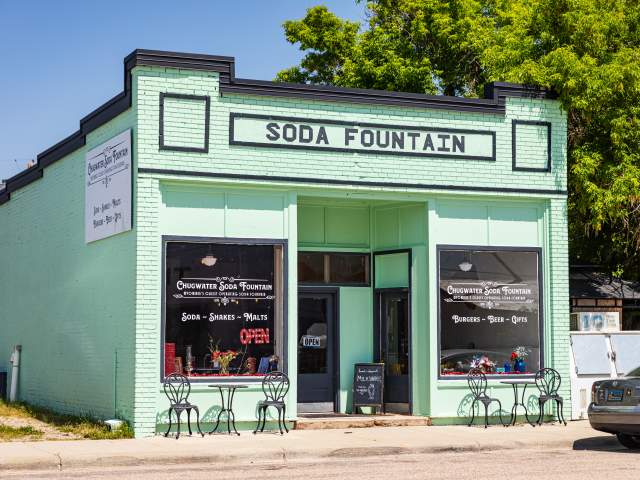
What says Americana more than soda? Nothing, and in Wyoming, the town of Chugwater is embracing the way they did in the good old days. Serving up fizzy sweets for the last 100 years, the Chugwater Soda Fountain boasts that it is the oldest in the state that is still operational today, in addition to being the town’s oldest business. Over the years, it has changed hands to new ownership, shifted from a dual pharmacy and soda counter to a fully-fledged restaurant and had to regroup after a building fire. For everything that has changed over time, a lot remains the same.
This famous Wyoming landmark runs five days a week in the summer, and its menu is still stacked with original recipe sodas and old-fashioned malts like you’d have found in the early 1900s. Keeping with the times, they have expanded their offerings to include many other delicious treats, from milkshakes to French toast to the wildly popular Chugwater Chili. Stop in for a bite, day or night, and get yourself a soda the way it was meant to be.
17. Big Boy Statue
Where to Find It: N. Fork Hwy, Wapiti, WY, 82414
We close out our list with an eye-catching mystery that is among the most unusual Wyoming landmarks, namely because its history is not widely known.
Back in 2013, a colorful statue appeared seemingly overnight in an otherwise vacant field on the side of a Wapiti highway bustling with visitors heading to and from Yellowstone. This figure wasn’t just any artwork — this was Big Boy, the mascot for the national chain of Big Boy restaurants. With a sly grin and a 50’s style pompadour, the overall-clothed boy stands with a juicy hamburger on a plate, his booted feet attached to a cement slab that keeps him anchored to his surroundings. Locals wondered how he got there and, more importantly, why?
Rumors flew, and Big Boy became the talk of the town, his reputation going home with many tourists that saw him while exploring the Wyoming countryside. While most people didn’t know how he got there, the truth was much simpler than the gossip: Big Boy is owned by James Geier, a local designer, artist and property owner who brought the statue to Wyoming from its former restaurant home in California. His goal? To give the people something to talk about. If you want to see Big Boy for yourself, you can find him about 20 miles outside of Cody headed west.
